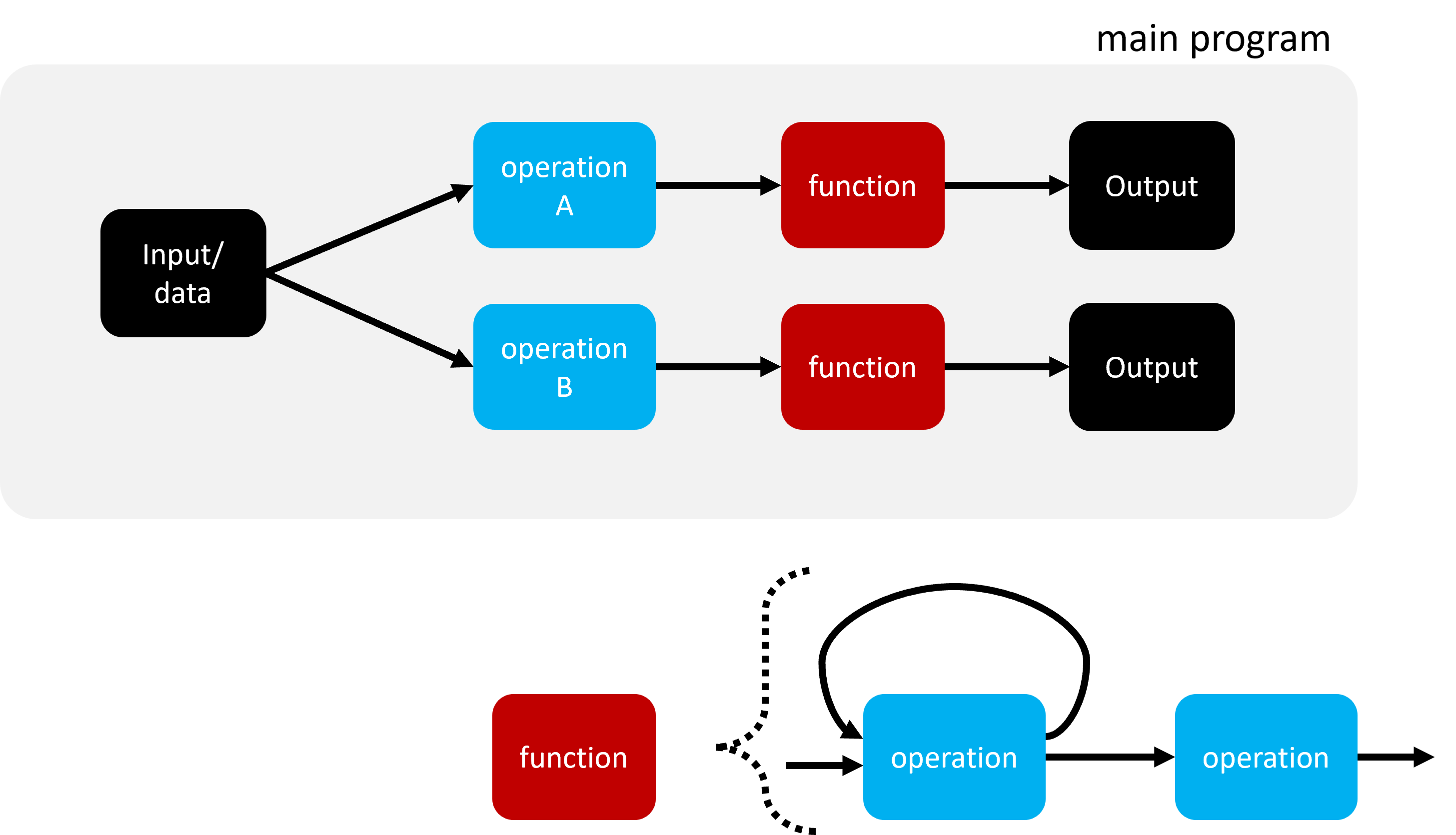6. Functions#
We have already used functions like print(), type(), and even int() or str().
These functions are built into Python.
Most of the functions we will use, however, will either be:
written (or: defined) by us, or
imported (loaded).
We will cover both cases.
Functions play a crucial role in creating more complex programs. They allow us to structure extensive workflows in a more logical and readable manner.

6.1. Defining Functions#
def good_thing():
print("Written once...")
print("... used 1,000 times!")
print("Saved three lines of code again.")
When we run this code, nothing happens initially!
Functions only execute when explicitly called:
good_thing()
This function does not return anything (only prints) and does not require arguments.
The general structure of functions is as follows:
def function_name(parameter1, parameter2, etc):
# code
return result
It’s even better to include a docstring, which serves as the basic documentation for the function. This can describe the function and its parameters, as well as provide examples or references.
def function_name(parameter1, parameter2, ...):
"""Description of the function.
"""
# code
return result
Functions can also have no parameters (e.g., good_thing() above).
Additionally, you can set default values for parameters, which are used if no new values are provided when the function is called.
def function_name(p1, p2=3.1415):
"""Description of the function.
"""
... code ...
return result
Here’s another example of a simple function with two parameters:
def x_vs_y(x, y):
"""Compare the numbers x and y."""
if x == y:
print("They are equal!")
elif x > y:
print(f"{x} is bigger than {y}")
else:
print(f"{x} is smaller than {y}")
x_vs_y(10, 70) # => 10 is smaller than 70
x_vs_y(0.000001, 1e-5) # => 1e-06 is smaller than 1e-05
But the following will not work:
x_vs_y(10) # => TypeError: x_vs_y() missing 1 required positional argument: 'y'
6.1.1. Default Values#
Here’s an example of a function where one of the two parameters has a default value:
def boxes_to_eggs(n_boxes, eggs_per_box=6):
"""Compute the total number of eggs in n_boxes boxes."""
return n_boxes * eggs_per_box
print(boxes_to_eggs(5)) # => 30
print(boxes_to_eggs(5, 10)) # => 50
print(boxes_to_eggs(5, eggs_per_box=10)) # => 50
print(boxes_to_eggs(eggs_per_box=10, n_boxes=5)) # => 50
However, this is not allowed:
print(boxes_to_eggs(n_boxes=5, 10)) # => SyntaxError: positional argument follows keyword argument
6.1.2. Optional: Parameter Order Matters#
With more parameters, the order becomes even more critical. Accidental mix-ups may result in functional but incorrect code:
def boxes_to_eggs(n_boxes, eggs_per_box=6, broken_eggs_per_box=0):
"""Compute the total number of eggs in n_boxes boxes."""
return int(n_boxes * (eggs_per_box - broken_eggs_per_box))
print(boxes_to_eggs(5)) # => 30
print(boxes_to_eggs(5, 10)) # => 50
print(boxes_to_eggs(5, broken_eggs_per_box=0.25)) # => 25
But consider this:
print(boxes_to_eggs(5, 10, 0.25)) # => 48
print(boxes_to_eggs(5, 0.25, 10)) # => -48 !!!
MINI Quiz
A function returns values/data to the program using…
a)
b)return
c)out
d)assertA function without a
returnstatement returns…
a) Nothing
b) The parameters
c) The variables
d)None
6.1.3. Return: Something Always Comes Back#
As we’ve seen, many functions contain a return statement. This does two things: it terminates the function’s execution and returns one or more values (e.g., return variable1, variable2).
However, functions don’t require a return statement. For example:
def double_print(input_str):
print(2 * input_str)
double_print("Hello World!") # --> Hello World!Hello World!
In Python, every function returns a value. If no return is specified, it implicitly returns None:
result = print("hello")
print(result) # --> None
6.1.3.1. Return Doesn’t Have to Be at the End#
A function can have multiple return statements, and they don’t have to be at the end:
def pick_smallest(a, b):
if a > b:
return b
if a < b:
return a
print("They look alike!")
6.1.4. Namespaces#
A namespace is an area within a program where a name (e.g., variables, functions) is valid. Python has three main types of namespaces:
Local scope: Valid within a function or method.
Global scope: Valid throughout the program or interpreter session.
Built-in scope: Names defined by Python itself.
Examples:
a = 5
b = 7
def do_stuff():
return a + b
result = do_stuff()
print(a, b, result) # => 5 7 12
Local and global variables behave differently:
a = 5
def do_stuff():
a = 1000
return a
print(do_stuff()) # => 1000
print(a) # => 5
Global variables are not recommended for modification within functions, as it can lead to unclear and buggy code. Instead, explicitly pass variables as function parameters:
def do_stuff(a):
a = a * 2
return a
do_stuff(10) # => 20
6.1.5. Mutable and Immutable Data Types#
Mutable objects (e.g., lists, dictionaries) can be modified within functions:
def modify_list(my_list):
my_list.append(42)
lst = [1, 2, 3]
modify_list(lst)
print(lst) # => [1, 2, 3, 42]
Immutable objects (e.g., integers, tuples) cannot:
def modify_value(a):
a = a * 2
x = 10
modify_value(x)
print(x) # => 10
In the next section, we’ll explore more advanced function types.
